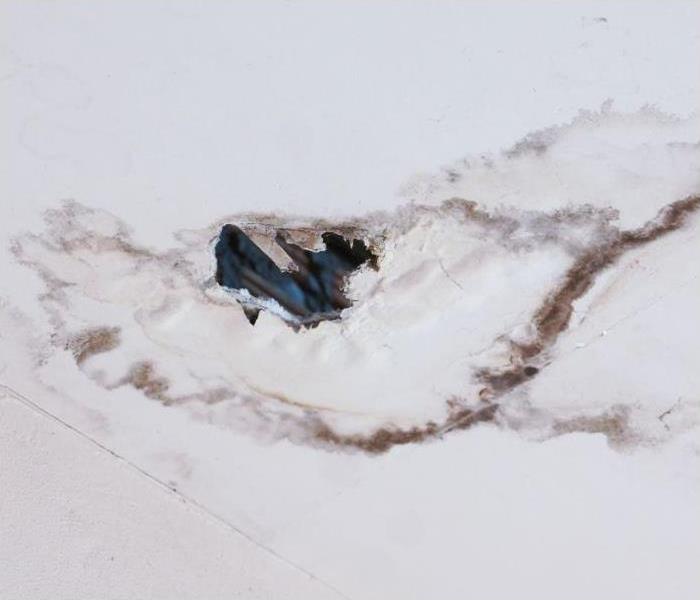Water Damage from a Roof Leak: Prevention and Restoration Tips
10/9/2024 (Permalink)
Water damage from a roof leak is a common yet serious problem for homeowners. While a small leak might seem like a minor issue, it can lead to significant water damage if not tackled quickly. Water infiltration through the roof can compromise the structural integrity of your home, lead to mold growth, and result in costly repairs. This makes it essential for homeowners to act quickly when a leak is discovered. Timely intervention is crucial, and professional services like those Weymouth water damage restoration experts offer can help prevent further damage and restore your home to its original condition.
Common Causes of Roof Leaks
Roof leaks can result from various factors, each leading to potential water damage if not managed properly. Some of the most common causes include:
- Damaged Shingles: Shingles can become cracked, curled, or missing due to weather conditions or aging, allowing water to penetrate the roof.
- Clogged Gutters: When gutters are blocked by leaves, dirt, or debris, water can overflow and seep into the roof, causing leaks.
- Improper Installation: Poorly installed roofs are more susceptible to leaks, especially during heavy rainfall or snowmelt.
Early Signs of Water Damage from a Roof Leak
Recognizing the early signs of water damage is crucial to preventing extensive harm to your home. Roof leaks often start small, making it easy to overlook the initial warning signs. Here are some of the most common early indicators of water damage caused by roof leaks:
Stains on Ceilings
One of the most noticeable signs of a roof leak is the appearance of yellow or brown stains on your ceiling. These stains are typically the result of water seeping through the roof and saturating the ceiling materials. Over time, the stains can grow larger as more water enters the home, eventually leading to sagging ceilings and structural damage.
Peeling Paint
When water infiltrates the walls of your home, it can cause the paint to bubble, blister, or peel. This is often a sign that moisture is building up behind the walls, which can lead to mold growth and further deterioration of the affected area. If you notice peeling paint, especially in areas near the ceiling or roofline, it’s important to investigate the cause and handle any leaks as soon as possible.
Mold Growth
Mold grows in damp, dark environments, making your attic or the area around a roof leak an ideal breeding ground. The presence of mold, particularly in the attic or on ceilings, is a clear sign of ongoing water leakage. Mold can pose serious health risks, especially for individuals with allergies or respiratory conditions, so it’s essential to tackle mold issues as soon as they are detected.
Warped or Buckled Walls and Floors
Water damage can cause walls and floors to warp, buckle, or become soft to the touch. This is a sign of significant water infiltration and structural damage, and it requires immediate attention to prevent further deterioration.
Preventative Measures to Avoid Water Damage
Preventing roof leaks and the resulting water damage involves a combination of routine maintenance and proactive measures:
- Regular Maintenance: Inspect your roof regularly for damaged or missing shingles and have them repaired quickly.
- Clear Gutters: Keep gutters free from debris to ensure proper water flow away from your roof.
- Repair Damaged Shingles: Handling shingle damage quickly can prevent leaks from developing.
Steps to Take When You Discover Water Damage
If you notice signs of water damage, it’s essential to act quickly to minimize the impact. Here’s what you should do:
- Contain the Leak: Place buckets or containers to catch dripping water and prevent further damage.
- Dry Affected Areas: Use fans and dehumidifiers to dry out wet areas, reducing the risk of mold growth.
- Document the Damage: Take photos and make a list of all the areas and items affected by the water damage. This documentation will be helpful when filing an insurance claim
- Contact Professionals: Reach out to a water damage restoration company immediately. Quick action can prevent the situation from worsening and reduce repair costs.
The Restoration Process
Water damage restoration is a multi-step process that ensures your home is thoroughly dried and repaired. The typical process includes:
- Water Extraction: The first step in the restoration process is to remove any standing water from your home. Professionals will use specialized equipment to extract water from carpets, floors, and other surfaces, helping to prevent further damage and reduce drying time.
- Drying: After the water is removed, high-powered fans and dehumidifiers are used to dry out affected areas. This step is critical to ensuring that no moisture remains, as even small amounts of water can lead to mold growth and further damage.
- Cleaning and Sanitizing: Once the area is dry, professionals will clean and sanitize the affected areas to remove any contaminants and prevent mold growth.
- Repair: The final step in the restoration process is to repair or replace damaged materials. This may include replacing drywall, insulation, flooring, and other materials that were affected by the water.
Don’t Let Water Damage Take Over - Act Now with SERVPRO of Weymouth, Hingham, and Quincy!
If you’ve spotted signs of water damage in your home, don’t wait until it’s too late. Protect your property and peace of mind by calling the experts at SERVPRO of Weymouth, Hingham, and Quincy. With our fast and reliable water damage restoration services, we’ll help you get your home back to its best condition in no time. Call us at (781) 337-0344 or complete an online form on our website.






 24/7 Emergency Service
24/7 Emergency Service
